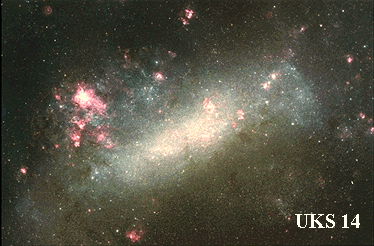
The Large Cloud of Magellan
Credit: Photograph made from plates taken with the UK Schmidt Telescope. Color photography by David Malin.
Copyright: Anglo-Australian Telescope Board
Discover the cosmos! Each day we feature a different image or photograph of our fascinating universe, along with a brief explanation written by a professional astronomer.
September 18, 1995

The Large Cloud of Magellan
Credit:
Photograph made from plates taken with the
UK Schmidt Telescope.
Color photography by David Malin.
Copyright:
Anglo-Australian Telescope
Board
Explanation: Magellan and his crew had plenty of time to study the southern sky during their famous voyage around the world. As a result, two fuzzy cloud like objects, nestled among the southern constellations of Doradus and Tucana are now known as the Clouds of Magellan. The Magellanic Clouds are small irregular galaxies, satellites of our larger Milky Way spiral galaxy. The Large Magellanic Cloud (LMC) pictured above is the closest galaxy to our own Milky Way, at a distance of about 180,000 light years. The Magellanic Clouds are joined to the Milky Way by a stream of cold hydrogen gas whose origin is still controversial. An unusual effect called gravitational lensing has recently been detected in a few LMC stars, and there is hope this could tell us important information about the true composition of our universe.
Tomorrow's picture: The Small Cloud of Magellan